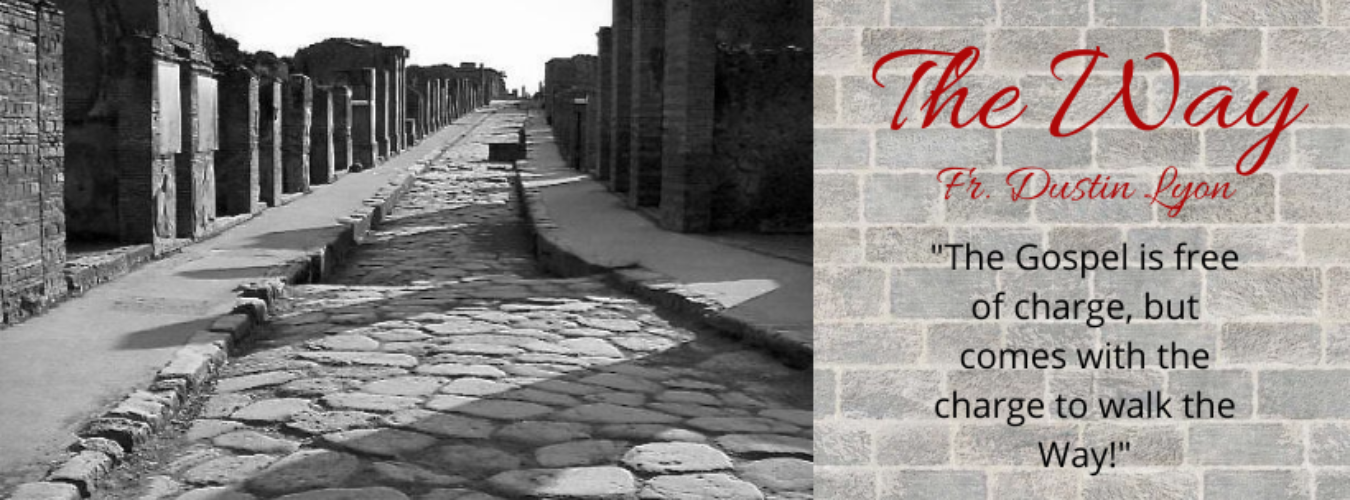The Death of the Theotokos is a major feast in the Church, but why does the icon of the feast depict her as a baby in a burial shroud? Part 2
(Read Part 1 by clicking here)
BURIAL CLOTHES ON JESUS’ FRIEND
If we continue to move through the Church year, the next icon we encounter with burial shrouds is the icon of Lazarus Saturday.
Most of us are familiar with this story from the Holy Gospel of John. A close friend of Christ’s, Lazarus, becomes terminally ill in Bethany.
Jesus hears of his illness, but holds back and doesn’t go right away to say his goodbyes. Only after Lazarus dies and has been dead for four days does Jesus find his way to Bethany.
It’s this very moment that the icon depicts. We see Jesus entering Bethany and calling Lazarus out of his cave-like tomb.
Behind Christ, his disciples lament. Around Lazarus stand other friends. Some of them are moving away the rock that sealed the tomb, while others cover their noses from the stench of death.
But Lazarus steals the scene. Though he has been dead for four days, he’s shown alive, walking out of the tomb – still wrapped in his burial shroud!
We don’t have a juxtaposition of birth and death, but we do have a juxtaposition of death versus life.
Indeed, as Orthodox Christians, we know that the raising of Lazarus points us to the resurrection of Christ. Like Lazarus, Jesus will come out of the tomb, not dead, but alive.
This icon hints to us that the one who was born to die on the cross will also rise from the dead. A sealed tomb will not hold him.
THE BURIAL CLOTHES OF CHRIST!
Finally, there’s one last icon with burial shrouds that comes to my mind.
It’s the icon of the Empty Tomb! The icon of the Resurrection! The icon of Pascha!
Here we find the Myrrh-Bearing Women bringing spices to the tomb of Christ. When they arrive, they find it empty. An angel sits at the corner of the tomb proclaiming the risen Christ. Where the body of our Lord should be is only empty burial clothes.
These burial clothes point to the resurrection of Christ.
He’s not here, for he has risen!
Resurrection has now happened in history to one person!
But this resurrection becomes contagious! And this is what the Dormition icon tells us.
UNDERSTANDING THE BURIAL SHROUDS
Let’s sum up and see if there’s a common theme.
If we recall the icon of the Nativity, we start to understand. The one who is born on Christmas day is the one who must die in order to rise again!
Then, in the icon of Lazarus, we start to put it all together. Death isn’t the end. Lazarus died, but Christ brought him back to life. It foreshadows Christ’s resurrection. There’s something more than death.
Then, Christ’s resurrection from the dead is confirmed in the icon of the Empty Tomb – it really happened! For the first time, someone has received new life!
Now, in the icon of the Dormition, we see that resurrection wasn’t just limited to Christ. Now a human rises from the dead. Resurrection wasn’t just an event for the Son of God, but it’s something that happens to all of us who are in Christ.
DEATH IS NOW A BIRTH
For Christians, death is now the path to life! Burial shrouds become our baby clothes.
St. Paul explains it all very well:
“Do you not know that all of us who have been baptized into Christ Jesus were baptized into his death?” (Romans 6:3 RSV)
But he doesn’t stop there.
“We were buried therefore with him by baptism into death, so that as Christ was raised from the dead by the glory of the Father, we too might walk in newness of life. For if we have been united with him in a death like his, we shall certainly be united with him in a resurrection like his.” (Romans 6:4-5 RSV)
As Christians, we are baptized into the death of Christ. It’s a death that becomes a new way of living. This is what we’re seeing in the icon.
The icon of the Dormition we get a foretaste of our own resurrection.
We see the death of Mary turned into a birth – a resurrection in Christ. A transformed, renewed life that is birthed only when one wears the burials clothes.
Fr. Alexander Schmemann puts it best,
“Death is no longer death. Death radiates with eternity and immortality. Death is not rupture but union. Not sorrow but joy. Not defeat, but victory. This then is what we celebrate on the day of the Dormition of the Most Pure Mother, as we anticipate, taste, and delight even now in the dawn of the mystical and never-ending day.” (Celebration of Faith: the Virgin Mother, volume 3, page 42).
P.S. Consider Exploring the Death of Mary with the Orthodox Church!
I now invite you to enter deeper into the mystery of Christ with the Orthodox Church!
St. Elias Services
Saturdays, 5 pm (at St. John’s Parish House, 1458 Locust St, Dubuque, IA)
Sundays, 9:30 am (at Hillcrest Chapel, 2001 Asbury Rd, Dubuque, IA)
Or find your nearest Orthodox Church by clicking here


